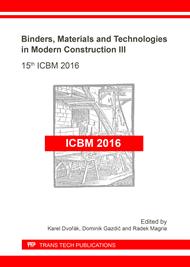p.76
p.83
p.88
p.94
p.100
p.106
p.111
p.118
p.123
Electrical Properties of Alkali-Activated Slag Mortar with Carbon Fibres
Abstract:
Building materials with enhanced electrical properties gain the importance in the new field of applications such as self-sensing or self-heating materials. In this paper, 3 mm long carbon fibres were used as a conductive admixture to alkali-activated slag mortar in order to reduce its resistivity. The amount of carbon fibres was ranging from 0.5 to 4.0% of the slag mass and the effect of the conductive admixture on the mechanical properties, electrical impedance, specific conductivity, and microstructure of alkali-activated slag composite was investigated. Only 0.5% of carbon fibres caused a significant decrease in impedance of alkali-activated slag composite and the addition of 4% reduced the impedance by one order of magnitude for low AC frequencies. However, due to problematic dispersion and higher demand of mixing water, the mechanical properties were deteriorated, especially at higher content of carbon fibres.
Info:
Periodical:
Pages:
100-105
Citation:
Online since:
October 2017
Authors:
Keywords:
Price:
Сopyright:
© 2017 Trans Tech Publications Ltd. All Rights Reserved
Share:
Citation:


